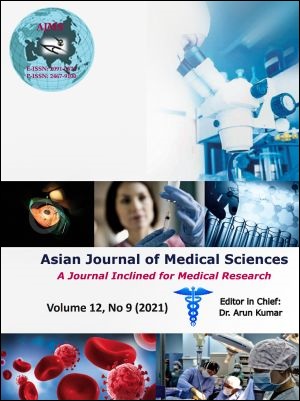Correlation of the severity of HRCT findings with the other hematologic parameters & viral load in patients with confirmed COVID – 19 Infection
Keywords:
Covid-19, D Dimer, HRCT, Viral loadAbstract
Background: The latter half of 2019 saw the spread of a highly contagious and fatal respiratory tract disease originating in the Hubei province of Wuhan in China which was labelled as COVID 19. Although a multi organ disease, it is seen to spread through the respiratory tract with lung being the primary target.
Aims and Objective: The study was conducted to correlate the severity of lung involvement as assessed by the HRCT severity, with the Viral Severity index, laboratory parameters, duration of hospital stay, viral clearance and resolution of lung symptoms.
Materials and Methods: An observational retrospective study was carried out from the laboratory records of consecutive 208 patients admitted to the tertiary care hospital between March 2020 to May 2020.
Results: Out of a total of 208 patients, 200(96%) recovered and 8(4%) expired. The expired patients showed a higher average age (50.79+/- 17.42; 62.25+/-12.37) years in the recovered & expired patients respectively (p=0.06). A longer duration of hospital stay was seen in the expired patients (15.05+/-9.55&18.62+/-10.22) days in the recovered & expired patients respectively. A low average (Hemoglobin) Hb values (12.17+/-2.01&10.9+/-2.31) g/dl in the recovered and expired patients respectively along with a higher total WBC count was seen in the expired patients (8.62+/-3.81& 16.86+/-12.79) k/U in the recovered and expired patients with a highly significant p value of < 0.001). Higher CT severity scores were seen in the expired patients (10.74+/-5.57&17.12+/-6.55) in the recovered and expired patients respectively (p=0.0018). None of the expired patients had a normal D Dimer level. HRCT values and the Rising D Dimer levels tend to show a positive correlation with the disease outcome and progression. The Higher Viral severity and HRCT score was associated with a longer duration of hospital stay reflecting a higher duration of viral clearance.
Conclusion: The Chest CT scores along with the laboratory parameters like the total WBC count and the D Dimer levels can together act as important parameters to monitor the Covid 19 disease course.
Downloads
Downloads
Published
How to Cite
Issue
Section
License
Copyright (c) 2021 Asian Journal of Medical Sciences

This work is licensed under a Creative Commons Attribution-NonCommercial 4.0 International License.
Authors who publish with this journal agree to the following terms:
- The journal holds copyright and publishes the work under a Creative Commons CC-BY-NC license that permits use, distribution and reprduction in any medium, provided the original work is properly cited and is not used for commercial purposes. The journal should be recognised as the original publisher of this work.
- Authors are able to enter into separate, additional contractual arrangements for the non-exclusive distribution of the journal's published version of the work (e.g., post it to an institutional repository or publish it in a book), with an acknowledgement of its initial publication in this journal.
- Authors are permitted and encouraged to post their work online (e.g., in institutional repositories or on their website) prior to and during the submission process, as it can lead to productive exchanges, as well as earlier and greater citation of published work (See The Effect of Open Access).




